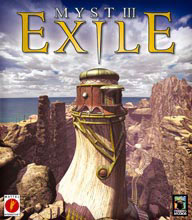
 |
 |
 |
 |
 |
 |
 |
|---|

|
|---|
Very immersive and enguaging... imaginative environments... interesting puzzles... annoying characters... improvement from the last Myst...
+
1) Being able to pan around a fully rendered environment, and look around it as you would in real life is much more immersive than in previous Mysts where you had to click the side to see 90 degrees to the left or right. Panning with the mouse is, by far, the biggest WOW about this game and it gives that player a unique experience.
2) The puzzles in the Myst adventure game series have a certain intrigue about them that sets them apart from other adventure games where you have to do things like use the banana on the monkey. As you are solving, for example, the puzzle on Voltaic with the red steam valves, solving the puzzle causes a nearby airship to inflate and drift by you. When you manipulate things in your environment you are often rewarded with spectacular visual displays of your environment changing before your eyes in ways that just make you say, "WOW, that's cool." Although maybe not so cool to a FPS player.
3) The story was told better this time around - it was easier to understand what was happening.
4) The artwork and architectural design was very imaginative and full of wonder. On the first island, there are are four tusks sticking out the of smooth, rocky landscape that covers the island. Each area is lined with Jules Verne esque metallic lining, pathways and bridges. The unique architecture of the Myst worlds and the immersiveness of the environment makes exploring the different ages a very enguaging experience.
-
1) As in all adventure games, this game lacks solid, addictive gameplay.
2) The guy with the long hair has got to be one of the most annoying characters that I have ever seen in a game. Everytime I saw him I was thinking to myself, "Get a haircut... take a bath... stop having a temper tantrum and just calm down... relax your face..." Some of the other characters were also annoying in their owm right. Catherine had an overdone english accent, Atrus seemed to talk like he was lost in his own emotional struggle all the time. Every character seemed to be on the verge of a nervous breakdown. I didn't like it.
3) Although the people at Presto Studios did do a better job of telling the story to the player, doing it that way took something important away from the Myst series - it lost some of its sense of MYSTery. In Myst and Riven, which were made by Cyan, much of the story was unravelled by the player finding somebody's journal in a room somewhere. Hearing the story through different people's journal writings made the story more abstract and mysterious. The player might then look around the room and imagine what had gone on here before. In Exile, however, most of the story was unravelled by Mr. Need-to-see-a-shrink showing up, waving his arms around, and yelling at you, which made hearing about the story not only painful, but also less mysterious. This takes something important away from the emotional feel of the Myst series.
4) Some of the ages, particularly the plant age, made it very difficult to tell which directions the player was free to move in, mainly because it was too dark. If the player just had a map, navigating the ages would be less frustrating.